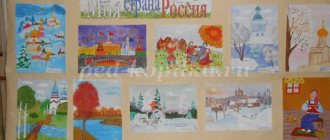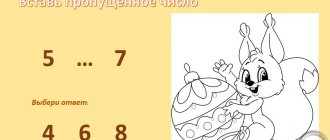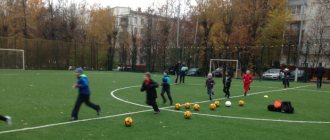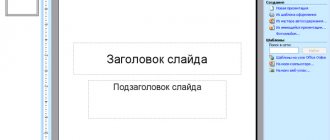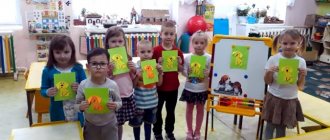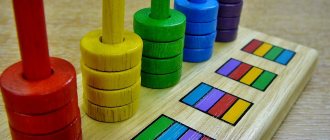Dear adults!
The game is intended for the emotional and intellectual development of children aged 5-9 years. Children become familiar not only with the names and characteristic external features of the 8 basic (innate) emotions, but also learn to distinguish and compare emotional sensations, both their own and those of others. Mood is a stable experience of emotions. By playing with emotions, kids will learn to control their own mood, which will positively affect their relationships with the outside world. In our theater there are 8 main roles: Interest, Joy, Surprise, Sadness, Anger, Disgust, Fear, Guilt, presented in the form of masks. In addition, 4 characters participate, by whose appearance children must determine their role and emotion. The game develops voluntary attention and thinking and is suitable for those who can read and those who are learning to read.
GAME COMPLETENESS:
1. 8 mask cards;
2. 4 cut cards with characters (32 pieces);
3. Envelope for cards;
4. Rules.
Cut the paired mask cards in half into separate cards, and the character cards into small cards (32 pieces).
RULES OF THE GAME
OPTION 1.
Invite the children to carefully examine the mask cards and draw their attention to the variety of external signs of the manifestation of emotions, their differences and similarities. Talk about when a particular emotion arises. Distribute the mask cards equally among the players. Let everyone try to depict this emotion on their face. The presenter shows small cards one at a time, choosing at random. Children must collect 4 cards for their mask with characters experiencing the same mood: cards with joyful characters are collected for the mask of joy, cards with sad characters for the mask of sadness, etc. The one who collects his heroes faster than others wins.
OPTION 2. "One actor theater"
This game only involves single cards. The players' task is to collect all the pictures related to one character. The presenter distributes one card with a hero. After this, the players take turns passing the rest, one card at a time, to their neighbor on the left, in a circle, one at each turn. The player keeps cards that are suitable in content. The first one to collect his character's emotions wins.
OPTION 3. "Master Class".
Put on an impromptu performance!
The game involves all cards and cards that are folded together, face down. Players take turns choosing a card or card and, without revealing its contents to other players, depict this emotion and character. The rest of the participants guess the mood by facial expressions and pantomimes.
The one whose performances were more successful and understandable wins.
4 OPTION. "Golden Mask".
Only mask cards are used in the game. They can be cut along the lines into 4 parts. These parts are turned over and mixed. Children, choosing one at a time, must reassemble the mask. The one who collects the mask the fastest wins.
Multimedia didactic game “Journey to the world of theater”
Participants of the exhibition and competition:
Renzanova Olga Petrovna, teacher
Solodenko Natalya Yurievna
Senior teacher, highest qualification category
MADOU d/s No. 183 of the city of Tyumen
Multimedia didactic game “Journey to the world of theater”
"Journey into the world of theater"
Goal: to introduce preschoolers to theatrical art by solving computer problems on the topic “Theatre”.
Tasks:
“Artistic and aesthetic development”:
- · Develop an interest in theater arts.
- To develop the skill of creating an artistic image using theatrical expressive means (make-up, costume, etc.)
"Cognitive development":
- Strengthen children's understanding of the theater.
- Learn to establish cause-and-effect relationships between objects and phenomena.
- Develop the ability to model in the form of a theater poster.
- Develop computer skills and solve didactic problems.
“Speech development”:
- Activate your child’s vocabulary with theatrical terminology
- Improve the grammatical structure of speech when forming words with the same root (make-up - make-up artist, ticket-ticker, etc.)
- Cultivate interest in literary characters and literary works.
“Social and communicative development”:
- · Develop an interest in theatrical professions.
Multimedia didactic game allows you to:
- stimulate learning motivation;
- enrich the visibility of learning;
- review previously covered material;
- use as a final quiz game.
The computer game is based on didactic games: “The 3rd odd one”, “What did the artist mess up”; riddles, verbal and didactic game “Name the profession”, task for modeling a theater poster, dynamic pause - physical minute.
The multimedia didactic game “ Journey to the World of Theater ” is intended for children aged 5-7 years. Can be used by teachers in kindergartens in individual work with children of senior preschool age, parents for individual training at home.
Development program: Power Point
Equipment: screen, projector, laptop.
Rules of the game:
- Riddles or questions are written on the slides. It is necessary to explain the answer and click with the mouse to receive confirmation that the answer is correct, or select an answer option and click with the mouse on the selected option.
- If the answer is correct, you will hear a corresponding voice message.
- To go to the next slide, click on the “>” button in the lower left corner.
Usage form:
- individual work with a computer.
Method of use:
- a multimedia didactic game is used for individual learning;
- Based on the results of the completed task, the child receives verbal encouragement “Well done! Perfect!" and setting for the next task;
- Upon completion of all tasks, the child receives a reward - a musical postcard.
Educational effect:
ü Enrichment of vocabulary, development of coherent speech, development of word formation functions.
ü Learn to guess theater-themed riddles.
ü Learn to determine the month, date, day of the week and time by description.
ü Development and correction of cognitive processes: visual, auditory perception, memory, attention.
ü Revealing the ability to exclude and generalize based on identifying the essential features of objects.
Game difficulty:
The teacher has the right to expand the didactic computer game with the following tasks:
— seat the spectators according to the tickets. Task: Formation of the skill of ordinal counting within 20, the skill of orientation in space.
— expand knowledge about theater professions;
-add a slide – a task in which the preschooler needs to put on the actor’s makeup, choosing blush, mustache, nose, wig, etc.;
-expand knowledge about different types of theater. Several slides are introductory, the rest are in the form of games “4th odd”, “Find a pair”.
Variation of the game:
The variability of the game may depend on the goal:
- about knowledge of theater professions.
— to solve cognitive (mathematical) problems.
- knowledge of types of theater;
- knowledge of a literary work or characters, etc.
Based on the results of completed tasks, the child can be offered stickers, badges or other collectible material. If there is a certain amount of this reward material, the child moves to the second stage, etc.
Description:
(Slide 1) Title. The name of a didactic computer game.
(Slide 2) Inviting a preschooler to participate in the game.
(Slide 3) The preschooler needs to use a riddle to find out who is inviting him on a trip to the theater.
(Slide 4) The hero invites the preschooler to create a theater poster.
(Slide 5-9) The preschooler needs to establish cause-and-effect relationships between phenomenon, action, time and design a theater poster.
(Slide 10) The preschooler is asked to perform a dynamic pause - a physical minute.
( Slide 11) The preschooler is offered the game “Third Wheel”. Task: find a puppet theater.
(Slide 12-16) The preschooler needs to name theater professions. By guessing riddles - clues. The child is faced with the task of forming words with the same root (for example, make-up - make-up artist)
(Slide 17) Based on the results of the completed task, the child receives verbal encouragement “Well done!”
(Slide 18-20) The preschooler needs to determine what the designer got wrong when depicting the characters in the theatrical performance.
(Slide 21) Based on the results of the completed task, the child receives verbal encouragement “Excellent!” and setting up for the next task.
(Slide 22-23) The preschooler needs to determine the elements of the costume of the main character - Pinocchio.
(Slide 24) Based on the results of the completed task, the child receives a reward - a musical postcard.
Video of the game organization
MAGAZINE Preschooler.RF
Creative games and theatrical exercises in the process of communicating with children.Today we will try to talk about what and how to practically implement in the upbringing and education of children based on theatrical games and joint creative activities.
Why are we talking about creative games and theatrical exercises? To answer this question, we will conduct a short acting training. So we closed our eyes. We relaxed and imagined... no, not a vacation by the sea, but our group. Introduced? Now mentally listen to the intonation of your own voice, look at your facial expression, and how the children react to it. Many of you smiled and immediately understood what we were talking about. And we will talk about the problem of friendly, sincere and enthusiastic communication between children and adults.
Kind and nice people - educators conscientiously fulfill their professional duty, often losing naturalness and ease in behavior. Undesirable intonations appear in the voice, the smile disappears from the face. And if you work many hours under such pressure, keep the children within the required discipline, and at the same time give them more knowledge, develop skills and abilities...
Yes, it is very difficult, and this causes teachers to become tired and irritable, and children develop aggressiveness and stubbornness in behavior, and a negative attitude towards classes.
WHAT IS THE WAY OUT? In changing the stereotypes of pedagogical thinking, in the search for such education and training that would contribute to the emancipation and development of both children and adults. That is, in organizing joint exciting and instructive activities based on the play of imagination, the free expression of the child and the sensitive playing along of the adult. It is precisely these opportunities that theatrical activities contain, in which there is scope for imagination and the development of acting abilities of both adults and children.
Now we will try to do creative tasks that can be used in everyday communication with children, exercising their imagination, speech, attention, memory, while training our own acting skills and ability to improvise.
Theatrical games and exercises in communication with children.
Game exercises can be included in a variety of activities. They can be planned in advance and sometimes improvised. Learning to improvise is not easy. Therefore, it is better to start by studying theatrical games. Gradually, accumulating your own experience, you can learn to independently come up with creative tasks that develop attention. Imagination, speech, expressiveness of children's movements. The main thing is that the child does not feel that he is being taught, but is engaged in activities that are interesting to him, in which situations are created that require independent solutions.
It is also important that the teacher himself is as passionate as the children. This mutual interest and passion will help create a creative atmosphere in joint activities with children, help them discover their own capabilities, see and hear all the variety of colors and sounds that surround us.
However, in addition to passion, mastery of a varied repertoire is necessary - literary, musical, gaming. To this end, based on the works of D. Rodari and A. Rogovin, we conduct games and theatrical trainings. Carrying out such games does not require special equipment. The most important thing is the desire to play and a little imagination, and then everything that surrounds us can turn into fairy-tale elements. Children have known about this for a long time. Well. Let's learn from the children!
So, if you are ready to play and improvise, then let’s begin to consider creative tasks that, at your own discretion, can be included in a variety of activities.
Games to develop attention and creative imagination.
1. It is very important to teach children to listen carefully and determine:
- steps (whose are they?)
- street noise (what car passed?)
- the crunch of an apple being bitten, the rustle of paper, fabric, oilcloth...
- what is happening in the corridor, on the street?
- what happens in the box? (determine what is inside by sound).
2. Depict in pantomime the one you heard (cat, dog, rooster, frog, horse, mosquito, hare, bear, cow).
Games with improvised noise instruments.
- Each object can not only be examined and touched, but also heard how it sounds (if the object is shaken or knocked on).
- You can make a whole orchestra from a wide variety of items (washboards, pots, plastic bottles, etc.)
In the process of such musical exercises, it is important to teach children to listen to the timbre of sound, to imagine what this sound is like.
Sketches for communication.
This section causes the most difficulty for children. To make these exercises more accessible, let's start with "doll conversations" , since the use of dolls relieves mental stress and shifts attention from one's own self to the object - the doll.
Assignment: the children have bi-ba-bo dolls in their hands.
1. The dolls meet each other and say hello;
- ask each other about health
- say goodbye
2. One of the dolls accidentally pushed the other;
- asks for forgiveness
- receives an apology
3. The doll celebrates her birthday;
- a friend comes to see her. Congratulations
- one of the guests is late, asks for forgiveness
- one guest spilled compote, play out the actions of the hosts and the offender
4. Explain to mom why clothes are dirty after visiting kindergarten;
5. Apologize for breaking the sand structures when the ball rolled.
The content of the sketches can include studies on etiquette and culture of behavior.
Creative tasks to develop imagination and speech.
1. Enter the room as a character and say hello to the children. Here it is recommended to use cards depicting fairy-tale characters.
- say goodbye to the children
- congratulate with celebration
- ask what the weather is like outside
2. Games to develop speech and improvise dialogues. Children choose a card with a picture of a fairy-tale character and split into pairs.
Exercise:
- write a conversation between two characters
- invent their conversation on the phone
- send each other a telegram.
The games were invented by D. Rodari in the book “The Grammar of Fantasy”
Creative tasks for the development of pantomime.
1. Children choose a card with the image of a fairy-tale character.
Exercise:
- show how his character looks in the mirror
- tries his favorite dish
- tries his least favorite dish
- listens to a compliment
- listens to the remark
- sits down on a chair.
2. Show a conversation with a foreigner who does not know our language. How to use gestures to explain where a store, train station, or restaurant is located.
3. Act out a situation in which one fairy-tale character steps on another’s foot on a bus. Show with the help of gestures how they sort things out.
4. Pantomime riddles:
- in a store (vegetable store, toy store, furniture store) guess what product the buyer needs
- in zoo. Guess who is sitting in the cage
- guess the profession (by characteristic movements, posture)
- guess what you are traveling on (boat, plane, train)
- guess the mood (by posture, facial expression, gait)
- guess what the weather is like outside
- identify a passerby by their gait (ballerina, soldier, old man, fashion model, man with tight shoes).
5. Show with hands:
- stand still
- come with me
- Goodbye
- let's make it up
- I love you
- I'm afraid.
6. Show body parts:
- how your back says "I'm an old sick man"
- how your shoulders say "I'm proud"
- how your finger says "Come here"
- how your eyes say "No"
- the way your mouth says "I love these cookies"
- how your ear says "I hear a bird"
- the way your nose says “I like it .
The tasks were proposed by M.P. Chair.
Sketches for the development of creative imagination.
As K.S. believed Stanislavsky, creativity begins with game circumstances. In a gaming situation, children easily accept all the conditions and begin to act in a fictitious situation, for example:
1. Go to the table and look at it as if it were:
- royal throne
- aquarium with fish
- bonfire
- bush of blooming roses.
2. Pass the book to each other as if it were:
- piece of cake
- crystal vase
- dirty handkerchief
- brick
- bomb.
3. Take a pencil from the table as if it were:
- hot baked potato
- small bead
- worm.
4. Perform various actions:
- peel potatoes
- string beads on a thread
- there is cake.
Exercises to distinguish colors.
What color is lemon? Let's see who has yellow in their clothes. (Children look at their clothes and the clothes of their friends.) Then you are asked to look at all the objects in the room and select them in accordance with the given color. Then remember what else is yellow (another) color. The one who names the most items wins. To count the correct answers, it is convenient to use chips, pebbles, acorns, etc.
So, we played the most typical theatrical games and exercises for the development of attention, speech, and creativity. Many tasks are far from simple. However, in practice it has already been proven that children easily get involved in such games and play with pleasure. Creative tasks can be invented ad infinitum. It is important that they are carried out as a joint activity between children and adults. An adult has to solve many difficult tasks: constantly maintain interest in the game, quickly respond to children’s manifestations, and creatively play their role. This style of communication leads to important results:
- develops creativity
- enriches with new knowledge
- promotes a subtle perception of the surrounding reality
- develops the ability to sympathize and empathize
- makes the communication process truthful.
And it’s worth working hard for!
Features of the musical development of children in the family.
The foundations of a child’s musical development are laid in the family. There are two main factors that determine the features of this process:
- Congenital musical abilities that influence the further musical development of the child and are determined by the genotype;
- The musical environment of the family, its attitude towards music and musical activities.
The early age of a child demonstrates the greatest sensitivity and readiness for musical development. The prerequisites for the functional structure of the brain necessary for early musical development are formed during the period of embryonic development. Neurophysiologists believe that it is early auditory experience, musical play, and the very presence in a rich musical environment that contributes to the maturation of the necessary neural connections in the structure of the child’s brain.
Recent studies indicate that the mother's musical activity (singing, playing musical instruments, moving to music, musical perception) has a significant impact on the child already at the embryonic stage of its development.
Scientists note the total duration of the period of musical sensitivity - from approximately two - two and a half to eleven - thirteen years. Individual variability in musical sensitivity is associated with heredity, which determines the “speed of maturation ,” with the conditions of the musical environment and the intensity of musical training. The interaction of these three factors is associated with the characteristics of the musical development of gifted children.
| Next > |

